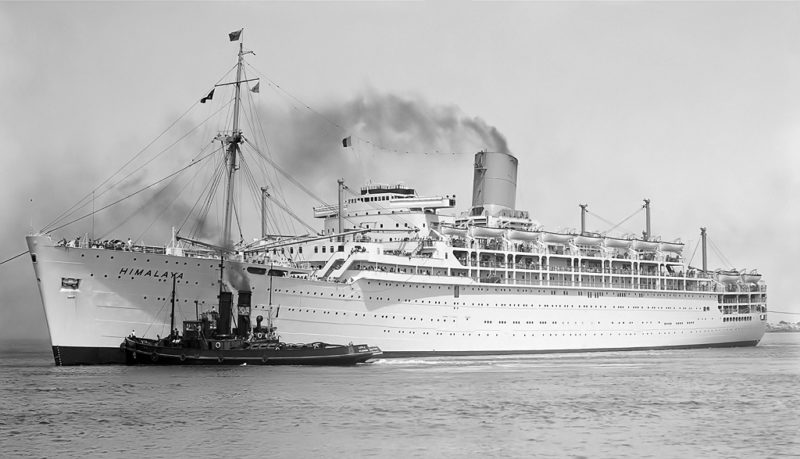
During the Second World War the P&O Group suffered heavy losses, with a total of 19 ships being lost. In addition to freighters, those losses included seven passenger liners and the custom-built (11,279grt/built1938) troopship Ettrick. The German U-boat U-155 torpedoed this vessel on the 15th November 1942, 150 miles west of Gibraltar.
In order to replace these losses and to resume the regular Far Eastern and Australian trade, two new, modern, passenger/cargo liners were ordered from Vickers Armstrong & Co. Ltd., at Barrow in Furness. These would be the Himalaya, intended for the UK to Australia service and the Chusan for the Far Eastern service.
Although very similar in appearance, Himalaya at 27,898 grt was slightly larger than Chusan at 24,215 grt. Himalaya had the same hull dimensions and mould as the Orient Liner Orcades, although when completed, they would present a different appearance. They were consecutive builds in the shipyard, Yard No. 950 being Orcades and 951 Himalaya.
Chusan was intended to supplement the three ‘Far East Sisters’, Corfu (14,251grt/built 1931), Carthage (14,304grt/built 1931) and Canton (15,781grt/built 1938) all of which had served with distinction as Armed Merchant Cruisers and then troopships during the Second World War. Fortunately all three survived and entered service after the war being refurbished to a high standard. Chusan was also a replacement for Viceroy of India (19,648grt/built 1929, which was lost on the 11th November 1942 after being torpedoed by U-407.
Of the three other, but older, ‘C’ Class ships on the pre-war Far Eastern service, Comorin (15,116grt/built 1924), Cathay (15,104grt/built 1925) and Chitral (15,248grt/built 1925) the first two were lost during the war, and after surviving the war the third was converted to an immigrant carrier for the increasing UK to Australia immigrant trade. She was not refitted to a very high standard and was scrapped in 1953.
HIMALAYA
Himalaya was the third ship in the P&O fleet to carry the name, and was ordered from Vickers Armstrong at Barrow in Furness in January 1946. Her keel was laid in April 1946 and she was intended to be the elite ship for the route.
Lady Currie, the wife of the P&O Chairman, Sir William Currie, launched her on the 5th October 1948, and her trials took place on the 24th August 1949. Over the measured mile off the Island of Arran Himalaya logged a speed of 25.13 knots. Sir William Currie was also a passenger on the ship’s maiden voyage to Australia.
Himalaya had cost just under £3.5 million to build and was handed over on the 1st September 1949, about 18 months late and £1 million over budget. The ship was intended for the service to Australia from Tilbury, calling at Gibraltar, Marseilles, Naples, Port Said, Aden, Bombay, Colombo, Singapore, Fremantle, Adelaide, Melbourne and Sydney.
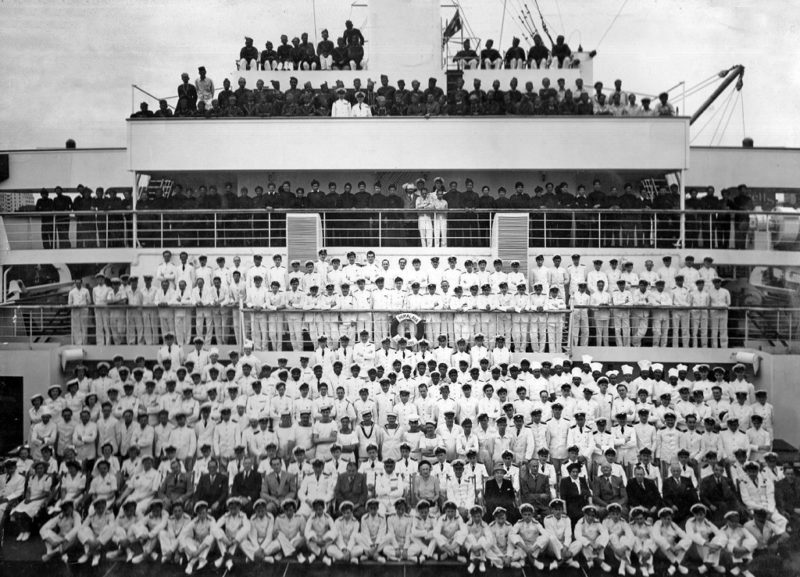
Details of Himalaya
- Gross Tonnage (as built) 27.898, 15,443 net, 9,659 deadweight, (1963) 27,989 grt, (1969) 28,047 grt.
- Length 708 ft. 6 inches, beam 90 feet 6 inches, draught: 31.2 feet.
Engines
Pametrada double reduction geared turbines with an shp of 34,000 and up to 42,500 shp with propeller revs. of 130 and 140 rpm respectively. The high-pressure ahead turbines were of the impulse-reaction type whilst the intermediate pressure ones were all-reaction and the low pressure were double flow. Double reduction gearing was fitted to the HP turbines whilst the IP and LP had single reduction. Impulse turbines provided astern power. A three-row HP impulse wheel was shrunk on to each IP rotor shaft, whilst a similar LP wheel was incorporated at the forward end of each LP ahead rotor. The ship carried Four Foster Wheeler (two large and two small) controlled superheat boilers 600-800 f. with a steam pressure of 525 lbs. sq. inch.
Two 4 bladed bronze propellers 19 feet in diameter and weighing 24.5 tons were fitted. Service speed was 22 knots.
Electrical power was provided by four 850 kW Turbo Generators with two 100 kW emergency diesel generators, and air conditioning was provided in her dining rooms and first class accommodation.
The vessel was fitted with a ‘Weir’ evaporating plant for distilling seawater. This could convert 350 tons of seawater per day including 30-35 tons double distilled for the boiler feed.
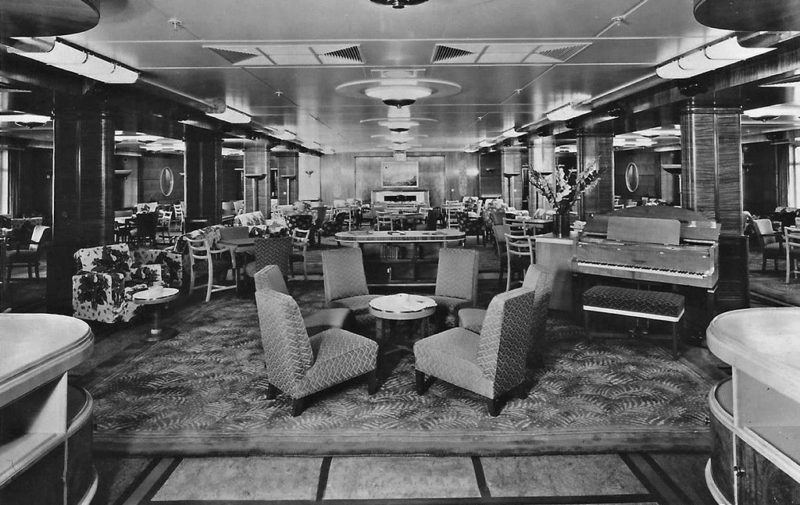
General Equipment
Steering gear was of the electro-hydraulic type with two power units either of which could provide the necessary power for all normal requirements. For rapid manoeuvring both were used together.
The windlass and two capstans forward and two aft were electrically driven. She carried four anchors of the stockless type.
Navigational Equipment included the latest, which was available. Radar was fitted as direction finding and a very comprehensive wireless installation. A gyro compass and gyro pilot were also carried along with an echo sounder and a couple of logs of Chernikeef and Trident pattern.
Fire protection was especially comprehensive with an automatic sprinkler system being installed for passenger and crew areas. Cargo spaces and storerooms had smoke detecting installations and foam equipment was provided for the boiler room.
Passengers as built 758 first class, 401 tourist class, Crew 631.
Himalaya had six holds with a cargo capacity of 435,000 cubic feet. (235,000 cubic feet insulated).
She was painted all white with red boot topping; her funnel was yellow, with masts and derricks buff to yellow.
Himalaya had eight continuous decks, seven of which were passenger and crew accommodation, a lower G deck was only a partial deck. The decks were, boat deck, promenade deck then down from A to F decks. Passenger cabins consisted of 443 first class and 147 tourist class cabins. With her route requiring the carriage of large amounts of cargo both on outward and homeward sailings, her three forward holds carried 235,000 cubic feet of refrigerated cargo. Her cargo handling gear consisted of two 10 ton and twenty-two 3-ton derricks with twenty-four winches of 26 hp each.
The highest decks on the ship, and separate form the passenger accommodation and lounges, was the three storied bridge structure, with the boat deck below. The ship carried 20 lifeboats, 16 on the boat deck and six aft (one either side double banked) on A deck. The boat deck was also the first class sports deck, with the promenade deck below and then A deck down to E deck.
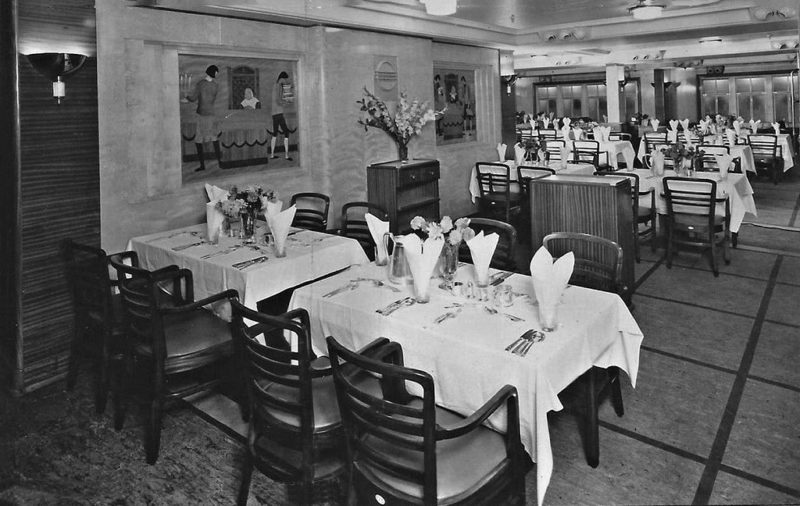
The bridge had a chart room directly behind it, and stairs led down to the middle level and at the front overlooking the forecastle was the Captain’s office and his private quarters. The First Officer’s quarters were also located on this level.
On the lowest level of the bridge structure were the Chief Engineer’s quarters, other senior officers and the radio room.
The boat deck offered a large area for sports and other activities. This deck was laid out for nine deck tennis courts and twenty-eight quoits pitches.
Notably absent from the boat deck were the usual ventilators, which often marred the appearance of a ship. These were incorporated into the superstructure and formed louvered slats to provide the necessary ventilation. The single 56.5 feet high funnel was in the centre of the ship and had to be modified later as soot/smut often landed on the pristine decks.
At the fore end of the Promenade Deck was the first class children’s play room with toilet facilities, and spacious netted play area outside on either side. Snacks and drinks were also provided at appropriate times. The entrance to this play area was via a staircase in the interior of the ship on the starboard side.
Situated in the main interior on the Promenade Deck either side of the lobby, were two small lounges. The lobby had a central double main staircase leading up to the boat deck with lifts down to the lower decks.
Either side of the lobby were doors out onto the Promenade Deck, which was a wide fully covered deck with a glass-enclosed section at the fore end.
Aft of the lobby were double thick glass doors that led into the main lounge and featured a host of fine Australian timbers. Forward on the port side was a steward service only bar.
Aft of the main lounge were two doors, one on the starboard side leading to the library and writing room and the one on the port side to the Australia Room which was panelled with the best Australian timbers and curtains and covers designed and made in Australia.
The library and writing room were furnished with heavy leather sofas and comfortable lounge chairs, with four tables and chairs for writing letters.
Aft of the library and writing room was the ballroom, which looked like a huge indoor deck space, but with tables and chairs around the sides. The ballroom could also be used as a cinema as well as for other games, ‘horse racing’ and children’s parties. Aft of the ballroom was the Verandah Café, which was also the smoking room and stairs towards the stern of the ship led down to B Deck.
A Deck consisted mainly of cabins, but also included the ship’s shop, as well as the ladies and gents hairdressing salons. Another fully covered and walk around promenade deck ran around A deck, with the first class swimming pool situated just forward of the pool café. The pool was surrounded by the ladies changing rooms and WC to starboard with the gents and pool attendant to port. The tourist class swimming pool was further towards the stern.
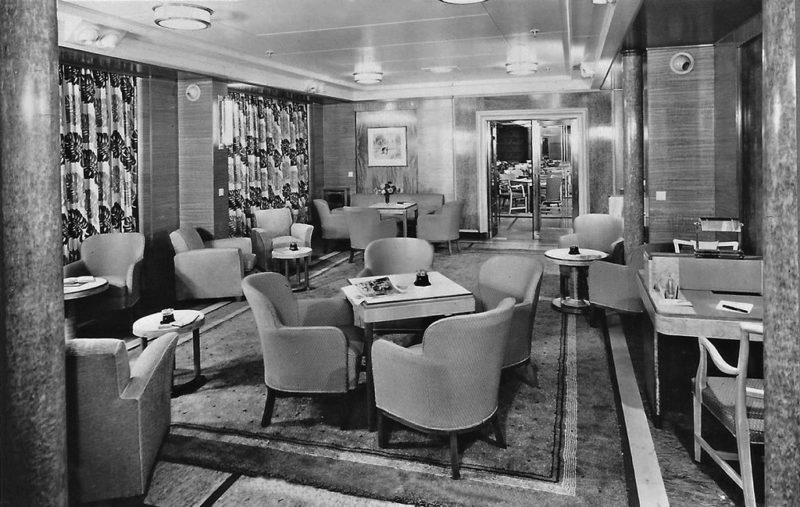
The majority of outside cabins on A deck had private facilities, whilst those without would use the public facilities that were numerous and frequently located nearby.
Tourist class cabins were situated aft on this deck, with a washbasin but shared facilities.
On B Deck amidships were situated the De-Luxe suites, one each side which contained a bedroom, lounge and a large verandah with windows providing views of the sea or country being visited. There was also a spacious bathroom and a large amount of wardrobe space, plus a trunk/suitcase room. Also on this deck were other single and two bedded cabins with either, a shower or bath plus toilet.
Tourist class cabins, with shared facilities were situated aft on this deck.
Also on B Deck were an ironing room, a telephone venue, the tourist class purser’s office, plus five other offices for administration purposes on the ship.
Aft of the purser’s office on the port side was the tourist dance hall and on the starboard side the tourist cinema.
C Deck, forward on the port side at the main lobby was a dispensary, where the ship’s doctor could be seen and far forward on the same side the ship’s hospital was situated with an operating theatre and four wards.
Forward on C Deck were two berth cabins with lower and upper berths, and cabins with either single or twin beds. All of these cabins had a washbasin, but shared facilities. Tourist class cabins were situated aft, again, with shared facilities. Also aft was the tourist class smoking room. Aft of the smoking room was the tourist class children’s play room.
The tourist class main stairwell commenced on this deck going down to E Deck. Just aft of the stairwell were two shops providing items that the passengers might need on the voyage plus souvenirs etc.
C deck was also the mooring deck with crew accommodation towards the stern.
D Deck contained the lobby and the first class entrance hall, with just seventeen cabins in front. These were either twin bedded or two berth cabins, all with shared facilities.
Directly aft of the lobby was the first class dining room situated amidships. This seated up to 389 passengers at tables for two, four or six. Aft on the starboard side of the dining room there was a small private dining room for special occasions. Further aft was the tourist class dining room, which could seat up to 208 passengers, with the galley in the middle. The galley could cater for up to 4,000 meals per day. Tourist class cabins were further aft, with a large lounge towards the stern.
E Deck had tourist class cabins aft to midships on the port side, and aft on the starboard side, with crew accommodation to the stern.
Following a short cruise down the Clyde and then to Southampton, Himalaya was officially handed over to P&O on the 1st September 1949. She arrived at Tilbury on the 11th September 1949, and made ready for her maiden voyage to Australia on the 6th October 1949 under the command of Captain D.M. Stuart DSC, who was Commodore of the P&O Fleet.
The maiden voyage was to Sydney, via Suez to Bombay, where the ship immediately reduced the passage time to 15 from 20 days, and the time to Melbourne to 28 days. From Bombay she sailed to Colombo, Fremantle, Adelaide, Melbourne and Sydney where she arrived to a great welcome on the 7th November 1949.
The six ships of the P&O and Orient Lines worked closely together and their schedules were organised so that arrivals/departures alternated between the two companies.
Early in 1951 an assessment was carried out on the water distilling plant fitted to the ship, and it was found to have been very successful saving 1,700 tons in weight and £1,500 on a ten-week voyage. Unfortunately both Himalaya and Chusan suffered from soot and smut from the funnel landing on the decks and it was necessary to find a solution.
Following the test of various suggested options, the smoke-deflecting top designed by Thorneycroft of Southampton was selected, Chusan being the first of the two ships to be so fitted. The new funnel top was fitted to Himalaya in 1953 and added about 12 feet to the height of the funnel but it was successful in alleviating the sooty problem.
It is interesting to note that the similar Orient Line ship Orcades, built immediately before Himalaya and with the same hull dimensions also suffered from the same problem. However the solution in this case was to add a ‘stove pipe’ extension to the funnel, which was also successful, but not as aesthetically pleasing.
During the 1950s Himalaya established herself on the Far Eastern run, undertaking cruises in the quiet season.
A voyage that marred the career of Himalaya occurred after commencing a voyage to Australia, departing from Tilbury at 1511 hours on the 27th August 1956, under the command of Captain H. Mallen, who had only taken over command of the ship two weeks earlier. The Chief Engineer was Mr F.H. Goodall.
Three days into the voyage when the ship was in the Mediterranean off the coast of Algeria there was an explosion in the refrigeration plant on the starboard side of E deck.
Two crewmembers were killed instantly, including the 1st Refrigeration Officer, Mr A.K. McConnel. Another 14 crew members were injured, some suffering extensive burns. The ship’s doctor, plus doctors and medical staff who were passengers assisted in tending to the injured in the ship’s well-equipped hospital. Unfortunately a further two of the injured died as a result of the explosion.
All the remaining injured were Goanese crewmembers and the ship headed at full speed for Malta, and the medical facilities available there, where they were taken to the Naval Hospital for treatment. Arriving at Port Said 48 hours after sailing from Malta, Himalaya sailed on into the Indian Ocean, where, unfortunately news arrived that another of the injured crew had now died. This brought the total number of those lost in the accident to five.
Himalaya arrived at Sydney on the 28th September 1956 and Captain Mallen was advised that his route back to the UK would have to avoid the Suez area with continuing tensions in the area, culminating in the seizure of the Suez Canal by British and French forces in November 1956. The voyage back would have to be via Cape Town and Las Palmas and terminating at Liverpool.
Major changes took place in January 1958, P&O and Orient Line services to Australia were extended to return via New Zealand, Fiji, Asia and the USA. The joint service was called the ‘Orient and Pacific Line’.
Following the success of the stabilisers fitted to Chusan from the time of her completion, during 1958 Himalaya had Denny Brown Stabilisers fitted by Creer, Silley Weir in London. The stabilisers cut down rolling by 60% and were controlled by a gyroscope, which used the effect of precession to generate an electrical impulse, which in turn controlled a hydraulic pump that altered the angle of the stabiliser fin. The action of the water over the wing either providing lift or dive to counter the effects of bad weather. Each fin projected about 12.5 feet from the side of the ship.
Himalaya was the first ship to commence this new around the world service departing Tilbury on the 12th January 1959. The round trip was 49,391 miles from the UK to Australia, New Zealand, Pacific Islands, Asia, Canada, USA, Panama Canal, Colon, Trinidad, Las Palmas and Tilbury.
During the winter months 1959/1960 Himalaya was given a major refit at The Rotterdam Dry Dock Company, Flushing when the vessel was given full air conditioning. In November 1960, at Tilbury, her dining rooms were re-named, the first class becoming the ‘Drake Restaurant’ and the tourist restaurant ‘The Tasman Restaurant’.
In May 1960 the management of the ship was transferred to the newly amalgamated P&O-Orient Lines. On the 8th November 1963 Himalaya arrived at Tilbury and was put into the hands of R. & H. Green and Silley Weir Ltd. for the vessel’s annual overhaul. However, on this occasion the refit was more extensive, and she was converted into a one-class ship.
The two small lounges beside the stairwell forward on the Promenade deck were renamed the ‘Hillary’ and the ‘Tensing’ rooms, and the first class lounge became the ‘Everest Room’, and the old first class Verandah Café was completely rebuilt, on the port side becoming the ‘Overland Bar’. The starboard side became a cinema with seating for 140 passengers. On B deck the tourist ballroom was split, the portside becoming the ‘Yeti Tavern’ and the starboard side the ‘Cascade Room’.
Aft on C deck the smoking room became the ‘Boot and Piton’ and the tourist class playroom was turned into the aft playground. At the aft end of D deck the tourist lounge became the ‘John Hunt Room’.
At the same time passenger capacity was increased to 1,416 by the addition of 280 berths. The gross tonnage of the ship was now calculated at 27,989 tons.

The first voyage following this refit commenced on the 21st November 1963 and the ship was primarily used on the UK-Australia run on the round the world schedule for the P&O-Orient Lines.
This involved the following vessels, Canberra (45,733grt/built 1961), Oriana (41,915grt/built 1960), Arcadia (29,664grt/built 1954), Iberia (29,164/built 1954), Himalaya, Chusan, Orsova (28,790grt/built 1954) Orcades (28,396grt/built 1948) and Oronsay (27,632grt/built 1951).
The full list of ports from the commencement of the round the world service included, London, Rotterdam, Flushing, Southampton, Le Havre, Lisbon, Gibraltar, Barcelona, Marseilles, Naples, Malta, Piraeus, Port Said, Aden, Bombay, Colombo, Penang, Port Swettenham (now Port Klang), Singapore, Fremantle, Adelaide, Melbourne, Sydney, Auckland, Wellington, Savu Savu, Suva, Pago Pago, Manila, Hong Kong, Kobe, Yokohama, Honolulu, Vancouver, San Francisco, Los Angeles, San Diego, Acapulco, Panama, Cartagena, Trinidad, Nassau, Port Everglades, Bermuda and London.
In June 1968 Himalaya sailed from Tilbury for a round the world cruise which took her 66,884 miles, calling at 51 ports and carrying 14,734 passengers, some of whom completed only part of the voyage. This was to be the vessel’s longest voyage returning to Tilbury six months later.
On the 10th October 1959 Himalaya departed from Tilbury for the last time, her base port being changed to Southampton.
From 1970 Himalaya was used almost exclusively for cruising and from May to October would sail from Southampton and in September 1970 the vessel undertook a one-way liner voyage to Sydney, Australia. Once in Sydney the ship would start a series of cruises around the Pacific and New Zealand.
Although a very popular ship, she was starting to show her age, and with the steep rise in the cost of fuel, especially for steam driven vessels, in May 1974 P&O announced that Himalaya was to be withdrawn from service at the completion of her Australian cruise season in October of that year.
During her 25 years of service notable passengers had included the entire Australian Cricket Teams in 1956 and 1961, as well as Lady Clementine Churchill en route to Colombo in 1956.
On the 16th May 1974 the vessel left the UK under the command of Captain J.W. Terry for the last time, for her final voyage to Australia, via Cape Town. The vessel spent the last few months of service cruising from Sydney, and at 1500 hours on the 10th October she sailed from Sydney on her final one-way voyage to Hong Kong. She sailed from there at 1600 hours on 26th November 1974 and headed for Kaohsiung, Taiwan.
After sailing 2.25 million miles over twenty five years, Himalaya arrived at the Tong Cheng Steel Manufacturing Co. Ltd. breakers at 0958 hours on the 28th November 1974 when she was handed over. The actual demolition of the vessel commenced in January 1975.
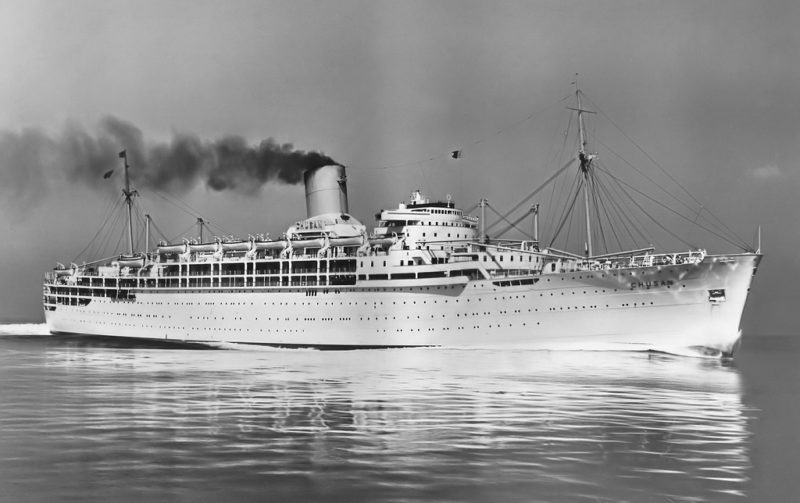
CHUSAN
Although not twin sisters, Chusan had a very similar appearance and layout to Himalaya and they shared the same machinery and water distillation plant.
Chusan was the first passenger ship to be fitted with anti roll stabilisers from the time of building, whereas Himalaya was retro fitted.
Chusan was the third ship in the P&O fleet to carry the name. Chusan (or Zhoushan) Island is an archipelago mid way down the east coast of China, which was appropriate as the ship was built for the Far Eastern Service. The vessel was ordered in May 1946 from the Yard of Vickers Armstrong, Barrow in Furness (Yard no. 964). She was the last ship built by Vickers Armstrong for P&O.
The keel of Chusan was laid in February 1947 and Viscountess Bruce, the wife of one of P&O’s directors, launched the vessel on the 28th June 1949. The ship left the Barrow yard on the 6th June 1950 and carried out speed trials on 9th June 1950, in the Firth of Clyde being delivered to P&O on the 14th June 1950.
The vessel was painted all white with red boot topping and her funnel was yellow with masts and derricks buff to yellow.
Details of Chusan
- Gross Tonnage 24,215grt (as built.), 24,261grt (1960), 24,062grt (1963) 24,318grt (1968)
- Length: 672.6 feet, beam 85.2 feet, draught 29 feet.
Engines/Electrical power/water distillation plant and general equipment were as per Himalaya.
Stabilisers
Chusan was the first large passenger ship to be fitted with Denny-Brown stabilisers. These were manufactured by Brown Brothers & Co. Ltd., of Edinburgh in conjunction with William Denny & Brothers Ltd. of Dumbarton. The two fins were fitted in an approximate horizontal plane in the vicinity of the bilges. Each fin was about 12 feet 6 inches long and 6 feet 6 inches wide, and when not in use, they retracted within the fin box inside the hull.
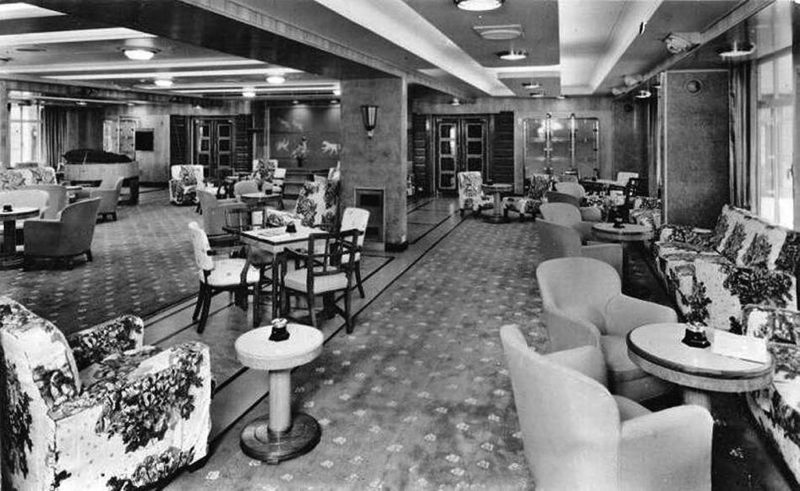
The stabilisers were only fitted shortly before the vessel was launched, and on the basis that if they were ineffective no cost would be incurred. Fortunately for the manufacturers they worked perfectly!
Like Himalaya, Chusan did not carry ugly ventilators, but had less obtrusive louvered intakes around the superstructure.
Passengers as built 475 first class and 551 tourist class, 1959/60. 464 first class and 541 tourist class, 1966 455 first class and 517 tourist class. Crew 572.
Chusan had eight continuous decks, seven of these containing passenger and crew accommodation. Ten main transverse bulkheads provided watertight subdivision. Decks were named from the Boat Deck down to the Promenade Deck, then A to F decks. There was then a further partial G deck.
The ship was fitted with six holds served by the same number of hatches, with a cargo capacity of 423,845 cubic feet (bales) and 22,505 cubic feet insulated.
Two 10-ton and twenty 3-ton derricks served the hatches with electric winches for their operation.
The Bridge Deck was a three-storey structure with the bridge and chart room at the top, below was the Captain’s day room on the port side with windows overlooking the forecastle, and private quarters on the starboard side.
Below, was further officers accommodation, the radio office and telephone exchange, officers bar and smoke room.
The Boat Deck was exclusively for the use of first class passengers. At the fore end immediately aft of the bridge structure, there were two glass screens, which ran fore and aft enclosing a large deck area. This deck contained tennis courts and quoit pitches.
As built the ship carried a total of twenty lifeboats, fourteen lifeboats on the boat deck, four aft on the promenade deck (two double banked) and two aft on A deck. Their carrying capacity varied from 99 persons to the 28 person emergency boats. These were all of steel construction since this was before the general acceptance of fibreglass. All except the motor and emergency boats had Fleming hand propelled gear. Gravity type davits were fitted and provided with electric winches.
On the Promenade Deck far forward was the first class children’s play area, including playroom with private facilities and large safe outdoor deck play areas on the starboard and port sides.
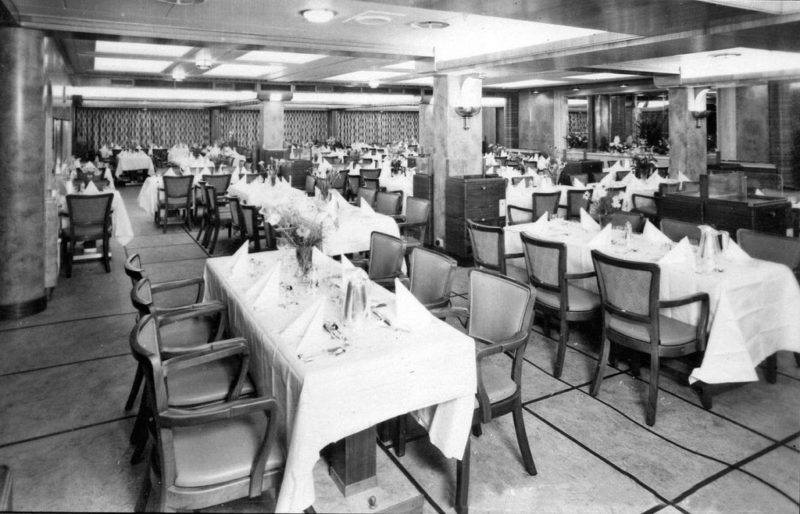
Next astern was the main part of the first class section, which contained all the public rooms. First being the Library and writing room separated from the main lounge by a lobby that had the main stairwell and two lifts as well as side doors out to the full walk around promenade deck.
The man lounge had huge casement windows and comfortable sofas, round drink tables and deep armchairs. Next came the ballroom, which could also be used as a cinema as well as dances, games and other entertainments.
The Verandah Café was to the stern of the main lounge and looked out over the first class swimming pool.
Down on A deck at the fore end was situated the Ladies Boutique and the Gentlemen’s Hairdressers, then there was the main lobby at the bottom of the stairs down from the Promenade Deck.
First Class cabins extended aft on both sides of the ship with the shop in the centre of the ship in the centre of the vessel facing aft along one of the transverse passageways. Further aft for tourist class passengers and separated by a bulkhead from the first class section was a hairdressers on the port side and general shops on the starboard side.
Next aft were two venues on each side of the ship’s service space. On the port side was a games and card room, and on the starboard side was a library and writing room. Immediately aft was the tourist class main stairwell that also had a lift in the centre. The stairs led up to the promenade deck and down to E deck. The main tourist class lounge was next which looked out to the stern and the tourist class swimming pool.
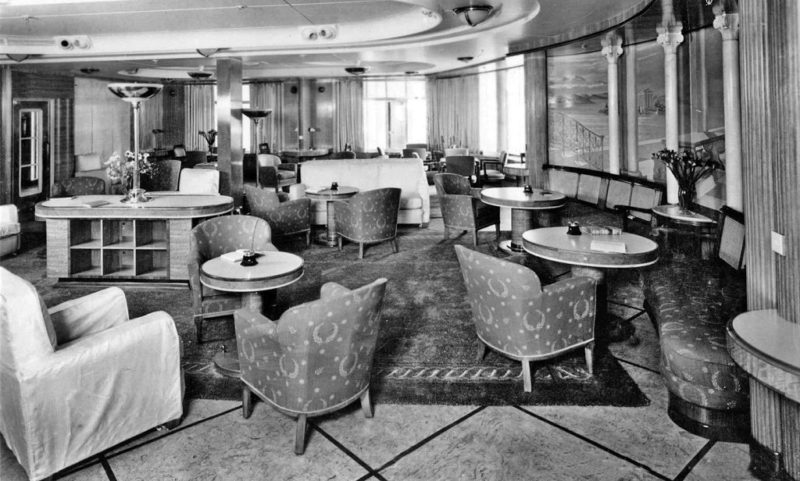
B Deck contained further cabins including two suites situated centrally on either side of the ship. These had a lounge outside and four windows with separate bedroom, a full bathroom, as well as a trunk and suitcase room. A large pursers office was located further aft in the centre of the ship and was shared with the tourist class passengers.
Aft of the pursers office was the tourist class ballroom which went right across the breadth of the ship, and next, towards the stern the second class smoking room.
Right aft on this deck European crew members were also accommodated, along with a mess room.
C Deck right forward was the ship’s hospital, with an operating theatre, three wards and accommodation for the medical staff. Also forward were first class cabins and aft the tourist class cabins, whilst further aft were the tourist class children’s playrooms.
Right aft was the mooring deck along with the European and Goanese crew accommodation, along with European recreation room and Goanese mess room.
Forward on D deck were the first class cabins, and then aft of the lobby was the air-conditioned first class dining room, which could accommodate 274 passengers. The dining room was located amidships and went the full width of the ship, with a small extension on the port side for the use of private diners.
The lobby was also the main entrance hall for passengers joining the ship. However, according to the tides, if the ship was low in the water against the quay passengers could board via the Promenade Deck.
The tourist class dining room was also on D deck and separated from the first class dining room by the main galley, larders, butchery space and bakery. This dining room was also air-conditioned and like the first class, could hold 274 passengers.
Further tourist class cabins were located further aft along with crew accommodation.
E deck had the largest number of tourist class cabins, and although they started further forward from around the main stairwell, they continued along the port side almost as far as where the first class dining room was on the above deck. Aft of a transverse passageway was a further section of tourist class cabins, and further aft accommodation for Goanese crewmembers along with a mess room.
Following her completion Chusan had been scheduled to make four North Atlantic crossings on charter to Cunard, however the vessel was delayed and her place was taken by Stratheden (23,732grt/built 1937). Instead she made a short voyage to Rotterdam with British Officials attending a freight conference.
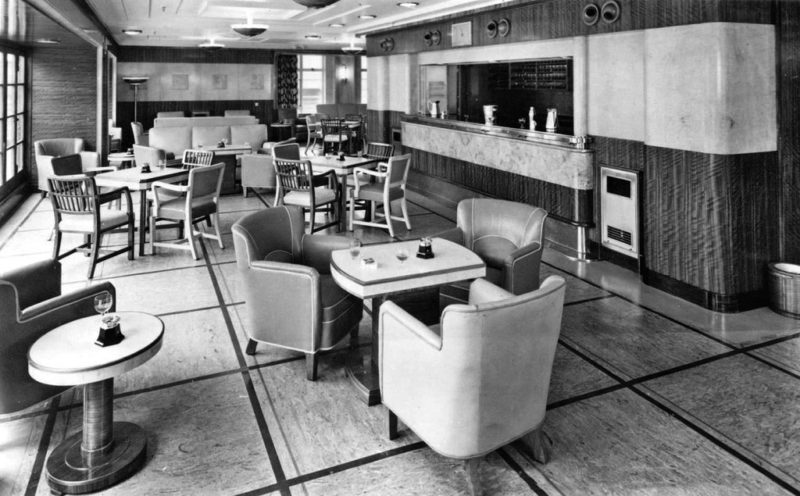
On the 1st July 1950 Chusan made her first maiden commercial sailing from Southampton to Madeira, on a first class only, shakedown cruise, which was to last seven days followed by a similar nine day cruise.
The first voyage to the Far East departed on 15th September 1950, however it only went as far as Bombay via the Suez Canal, the second full voyage to Japan from Tilbury departed on 7th November 1950. When the ship arrived in Yokohama it was the first time since the end of World War II that a P&O ship had berthed there.
From then on during the northern hemisphere winter months Chusan would work in conjunction with the ‘Far East Sisters’ Corfu, Carthage and Canton, the route being, Tilbury, Southampton, Gibraltar, Marseilles, Port Said, Aden, Bombay, Colombo, Singapore, Hong Kong, Shanghai, Yokohama and return.
During the summer and autumn months the ship was turned over to cruising.
The year after her entry into service, she cruised to Madeira, Casablanca, Lisbon, Naples and Barcelona. For those passengers who preferred less hot climes she also sailed to Sweden and Norway. In 1952 a similar pattern was set, but also included Genoa, Villefranche and further east into the Mediterranean to Rhodes and Athens.
As with Himalaya, Chusan was plagued with soot and smut from her funnel landing on her decks, and in May 1952 she was the first of the two ships to be fitted with the Thorneycroft designed funnel cowl. This was fitted by R & H Green & Silley Weir in London and added about 12 feet in height to the funnel.
On the 12th June 1953 Chusan collided with the T. & J. Harrison freighter Prospector (6,165grt/ built 1943) off the Goodwin Sands. Chusan suffered a 7.8 metre gash to her starboard bow, and had to return to Tilbury to effect repairs, which took two days.
On the 4th April 1959 the ship left Tilbury and made the first round the world voyage in the history of P&O. The cruise took 92 days and covered nearly 32,000 miles calling at ports such as Port Said, Bombay, Colombo, Singapore, Manila, and Yokohama. From there she sailed down the west coast of the USA to San Francisco, Los Angeles, Panama, Trinidad and Las Palmas arriving back in the Thames in mid July of the same year.
The cruise was also scheduled to sail from San Francisco to Honolulu and back via Vancouver with a two-day stay in Honolulu. However a US Senator objected to this leg as he maintained that it infringed US coastal shipping laws, and the vessel only stayed in Honolulu for eleven hours then sailed via the islands of Molokai and Maui to Hilo on the island of Hawaii. She then continued to Vancouver where, on 29th May 1959, the ship received a rapturous welcome upon her arrival before sailing down to San Francisco.
From December 1959 to March 1960 Chusan was refitted at the yard of Harland & Wolff, Belfast when air conditioning, supplied by the Carrier Engineering Company, was extended to the entire ship. The units supplied had fully automatic temperature control. Passenger The standard of the accommodation in the ship was also improved with more cabins being given private facilities. Chusan left Harland & Wolff’s yard on the 8th March 1960, arriving at Tilbury on the 10th March before sailing on to the Far East Service to Yokohama on the 25th March 1960
With a change in the patterns of the Far Eastern Service plus political unrest in Malaya, Burma, The Philippines, Indo China and the Dutch East Indies, the requirements for passenger carrying vessels diminished and her two running mates Corfu and Carthage were withdrawn in 1961, and Canton in 1962. However two smaller, second hand vessels, replaced these having been bought from Belgium after being made redundant with the independence of the Belgian Congo. These two ships became Cathay and Chitral, with a passenger capacity of only 226 passengers and a gross tonnage of about 13,800 tons they were more suited to the reduced number of passengers now wanting to travel to the Far East.
The P&O and Orient Lines passenger fleets came under joint management in May 1960 and round the world sailing was introduced in both east and west bound directions. In June 1963 Chusan transferred to the UK-Australia service, also commencing cruises from Australian ports. She also sailed from Australia to Yokohama via Hong Kong.
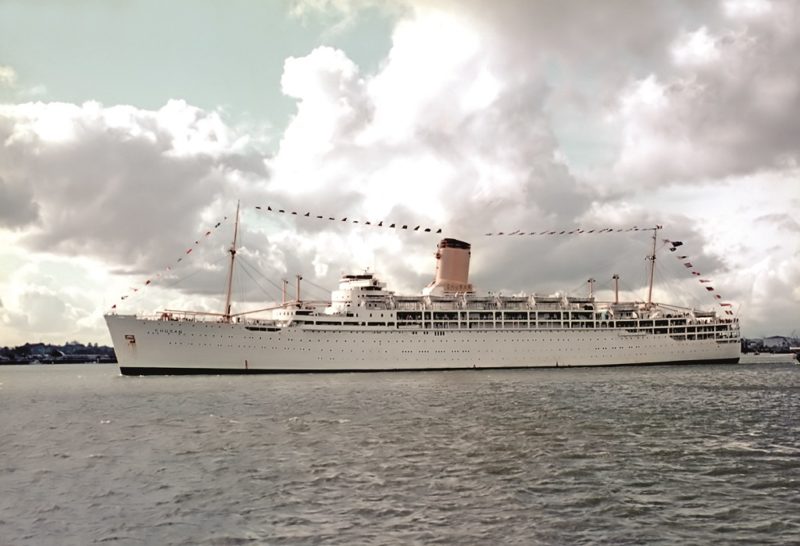
In 1966 her passenger numbers were again amended to 455 first class and 517 tourist class passengers. Under the command of some excellent and experienced captains Chusan had earned the reputation of being the ‘Happy Ship’ in the P&O Fleet and was very popular both on liner voyages as well as cruising.
In 1968 she was took an active part in the London to Sydney car rally. This left Crystal Palace, London at 2pm on the 24th November 1968, the cars driving across, Europe, and Asia. The first 70 cars to reach Bombay were loaded onto Chusan and taken to Fremantle to drive the final leg to Sydney.
In January 1970 Chusan left Tilbury arriving at Bombay on the 8th February 1970 the ship having the distinction of making the final scheduled call of a P&O ship at Bombay thus ending years on this service.
The ship transferred to the P&O Passenger Division in 1971 and early that year whilst en route from Auckland to Sydney one of the passengers became seriously ill. The vessel was too far from land to enable a helicopter evacuation, and an RAAF Hercules was despatched to drop the necessary drugs in the sea near to where the ship was sailing. These were recovered by one of the ship’s motorboats and a successful operation was carried out on board Chusan by her surgeon, Mr P.R. Wheatley FRCS.
On the 1st July 1971 Chusan suffered a fire in the funnel uptakes whilst berthed at Southampton. The First Officer N. Messinger initially spotted this when he saw smoke coming from the ventilators. At first crewmembers tacked the fire with fire extinguishers, whilst being sprayed with water. Soon the Southampton Fire Brigade attended and with the temperature in the engine room now in the 100s Fahrenheit, quickly extinguished the blaze.
From December 1971 to January 1972 the ship operated cruises from South Africa, to South America, and in 1972 cruises out of Southampton
However her end was not long in coming and on the 26th March 1973 she arrived back in Southampton for the final time before being sold to Mitsui & Co. sailing to the breakers at Kaohsiung where she arrived on the 1st July 1973. However she was re-sold to a local breaker three days later and demolition commenced on the 19th September 1973 by Chou’s Iron and Steel Company Ltd.
On the 8th May 1973 a Memorial Notice appeared in The Times,
“CHUSAN” – a grand old lady sadly mourned by Nicholas Messinger, his family and friends and all who sailed in her.

Nicholas Messinger was the First Officer who spotted the fire onboard the ship in 1971 and probably prevented it spreading and the possible early loss of the ship




Comments
Sorry, comments are closed for this item